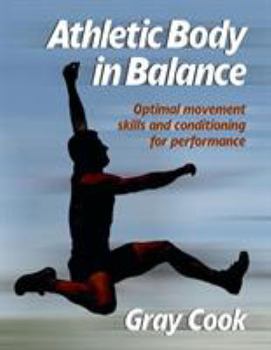Athletic Body in Balance
Select Format
Select Condition 
Book Overview
Physical...
Great athletes make difficult moves look effortless with a combination of skill, strength, and balance. Traditional conditioning builds a fitness base, but modern sports training takes into account athletic movement patterns. Athletic Body in Balance is the first guide of its kind to show you how to train for smooth, fluid movement and prevent muscle imbalances, mobility restrictions, stability problems, and injuries.
Format:Paperback
Language:English
ISBN:0736042288
ISBN13:9780736042284
Release Date:May 2003
Publisher:Human Kinetics Publishers
Length:232 Pages
Weight:1.50 lbs.
Dimensions:0.6" x 8.5" x 11.1"
Age Range:18 years and up
Customer Reviews
5 ratings
Body in Balance
Published by Thriftbooks.com User , 16 years ago
Athletic Body in Balance DVD I not only purchased the DVD, I also purchased the book. This is an excellent guide for making sure you don't develop muscle imbalances performing different workouts. I absolutely loved the self-tests which enabled me to decide what needs stretching and what needs strengthening. The DVD and book shows you specific exercises based on your tests results. Invaluable information!
Athletic Body in Balance
Published by Thriftbooks.com User , 16 years ago
This is an OUTSTANDING complement to the DVD. I hoped that the DVD and book would not merely be redundant...and they aren't! The overlap to some extent so that you can get results with only one or the other, but I am VERY glad to have both. They fill in some gaps that each has.
"Athletic Body in Balance" by Gray Cook accessible, comprehensive text for the non-pro who wants to
Published by Thriftbooks.com User , 17 years ago
I've only scratched the surface of the useful information in this book. It's full of stability, agility and explosiveness drills as well as strength and flexibility programs. Anyone interested in getting the maximum functionality from their body should take a look at Gray Cook's site, especially the Functional Movement Screen. The programs in this book reflect the information on the site and are easily understood by the enthusiast without an exercise physiology degree. Having gotten away from the bodybuilder-based mythology of my early years and moved on to core and performance-based programs, this book is a must for anyone wanting to get the best result for their training time.
Cook serves up some great advice.
Published by Thriftbooks.com User , 21 years ago
This should be required reading for athletes as well as coaches. The author does an excellent job in defining the "weakest link" as a cause of injury or tissue failure, and distinguishing between the too-often blamed "over-training" and the real culprit, improper training. Stability is emphasized, as it should be, as the basis for effective movement. (As my Burmese boxing coach once told me, it does no good to launch a rocket from a bamboo pad.) Other good points of emphasis, among many, are the need to relax to maintain fluidity with speed, and to "be quick but don't forget to stick." Again, in boxing we were always told to stick and move, but too often the person advising this had no idea of how to go about it, let alone teach someone else to do it. Gray Cook does. Throughout the book, his prose is effective, his explanations are clear and concise, and his recommended goals are accompanied by explicit step-by-step instructions to achieve them. For poviding the reader an understanding of athletic movement and training and actual how-to for practice and execution, this book tops my list.
Excellent conditioning guide
Published by Thriftbooks.com User , 21 years ago
Very thorough, almost tactical approach. The author in his preface states that "efficiency and effectiveness" are his central themes. As the title suggests, the book focuses on balance, stability, agility, and strength of "the core" to build up a non-sport specific conditioning guide. The thrust of the book is really towards improving overall athletism. There is definitely a clear emphasis throughout the book on the concepts of movement and space. The prose in the book and the depictions of different routines are very clear, and framed in a way that provides extra insights. A random example follows: "... Also a coiling movement is followed by an uncoiling movement that starts at the hips and then moves to the shoulders and arms. The weight shift is the trip hammer that sets the level of power. The goal is not to generate rotational power but rather to transfer linear or weight-shifting power into rotational power ... imagine an off-center playground seesaw ...You turned a short-distance force into speed because the long end traveled through a longer arc of movement in the same amount of time ..."






